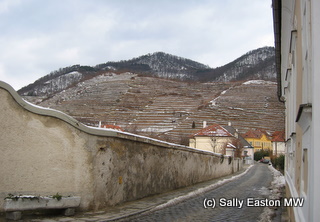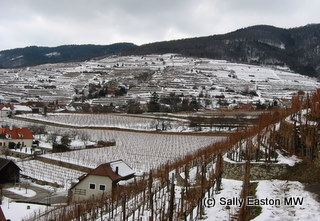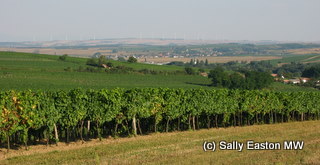Lower Austria
A shorter version of this article first appeared in Decanter magazine 2006, and was inspired by a visit to the region sponsored by Austrian Wine.
Lower Austria is the country’s biggest and most diverse group of wine regions, clustered in the north-east corner of the country, and accounting for over 60% of the country’s vineyard area. It is most important for white grape varieties such as grüner veltliner and riesling, the best of which rival the top, longest-lived, most highly respected dry white wines in the world.
Wachau, Kremstal and Kamptal

Terraced vineyards
The trinity of Wachau, Kremstal and Kamptal, at the western extremity of vine cultivation in Austria, close to the banks of the river Danube, and just one hour west of Vienna, is the origin for most of these globally celebrated wines, the pinnacle of which are dry, rich, concentrated and tautly defined wines of precision and place.
These three sub-regions comprise 7,500 ha between them, just 15% of Austria’s vineyard plantings.
The climate here is dry, and continental, with long cool autumns. Conditions uniquely combine to create consummate wine-growing potential. Warm winds blow from the Pannonian plain in the east. Some of these are funnelled up the river Danube to the eastern reaches of the Wachau, their influence waning westwards as they lose pace. Virtually all the vineyards in these areas are on the northern bank of the Danube, to catch maximum sunlight exposure during the growing season, and in places, especially in the Wachau, vineyards are precipitous and terraced, thanks to the work of the church in previous times, evidence of the centuries-long history of vine cultivation in Austria. The terraces add further motes of warmth by re-radiating the sun’s heat.
The Pannonian influence is strongest up to the eastern parts of Wachau, at Durnstein, where Richard the Lionheart was imprisoned. Just beyond the town, the Danube turns sharply southward, blocking the warm Pannonian air. It gets progressively cooler going west. As a result, wines from eastern Wachau can be more opulent, a little richer and more powerful than those to the west. At the western end, in Spitz, the meso-climate is wetter and cooler, almost 3°C cooler than at Loiben in the east of the region, and the wines more finely structured and minerally, with an almost exotic note.
Cool afternoon mountain winds come down from the Waldviertal, north of the region which enables grapes to retain natural acidity while allowing full, spicy, ripeness to be achieved. Aspect and precise location have a discernible influence on the wines.
Most Wachau producers are part of the Vinea Wachau group, the roots of which date to a 13th century land classification. The aim of the group is to safeguard the origin and improve the quality of their wines, which are all dry and are categorised according to style:
- steinfeder is the lightest in weight and alcohol (11%),
- federspiel of middling weight and
- smaragd the richest, most full-bodied style and with alcohol about 13%. Smaragd wines are named after the green lizards which come out to bask in the sunshine on the vineyard terraces.
It is usually the full-bodied smaragd style where the pinnacle of quality and longevity is found. Rudi Pichler, of his eponymous estate said “to show terroir, you need a single vineyard. Single vineyards are normally destined for smaragd quality, therefore, the best quality is usually the smaragd style”. Hirtzberger‘s Singerriedel Riesling Smaragd with density, freshness, intensity and concentration is surely one of the most sought-after wines in the entire valley.
The exemplary co-operative, Domäne Wachau, makes some excellent quality and good value riesling and grüner veltliner from single vineyard sites, and other producers to splash out on for a revelatory Wachau experience include Leo Alzinger, Emmerich Knoll, FX Pichler and Prager.

Picturesque slopes
Sandwiched between the Wachau and Kamptal, is Kremstal, with vineyards on either side of Danube tributary, the river Krems. Vineyards here are located on the world’s third largest loess terrace which extends about six kilometres from Krems to Gedersdorf (the largest is in China, and the second largest is the famed Kaiserstuhl vineyard in Germany). Riesling gives way to grüner veltliner as the dominant variety here.
Grüner veltliner grapes ripen fairly late, so it prefers cool nights to achieve perfect acid balance with alcohol and aromatic expression. It is another variety that expresses its terroir or site, and is at its best on primary rock with fertile top soil of either loess or shale origin, so this region provides some good examples. It has a spicy, smoky character with distinctive white pepper notes. Its fruit character ranges from citrus to rich, peachy and apricot flavours. Martin Nigl of his eponymous winery explained the diversity of styles with this grape variety: “there are three styles of grüner veltliner: a fresh, young style, the ‘golden middle’ with enough freshness and enough concentration so it can be an aperitif or go with a meal, and the concentrated style” which is a real food wine.
Centred on the town of Langenlois, a little further east from Kremstal, lies Kamptal, where the reputation for grüner veltliner is second to none. This is home to the iconic Willi Bründlmayer estate, and to numerous other top producers such as Schloss Gobelsburg, Hiedler and Hirsch.
The climate is a little drier, and the wines a little broader and richer than the Wachau. During the day, warm air from the southern plain of the Danube flows up the valley of the river Kamp while by night, a cool breeze from the Waldviertel blows over the vineyards and terraces down the valley. Geology remains important as a quality driver. Micky Moosbrugger, of Schloss Gobelsburg explained: “the most important soils are 280 million years old – brown, amphibolites, mica, schist. This is the basement of the whole Danube area through the Wachau, Krems and Kamptal areas. In Kamptal, there is a geological island at Gobelsburg, where alpine glacial deposits formed a croupe of big gravels, and another geological island at Heiligenstein, of Permian rock, sandstone and gneiss.” The Heiligenstein has a reputation of almost mythical proportion. An early mention in 1280 suggests it was a mountain on which the sun ‘burns like hell’ (or Hellenstein).
Langenlois is something of vinous mecca, and the Loisium opened in 2003 amid the vineyards, a futuristically shiny block of a wine visitor’s centre.
Wienviertal

Weinviertal turbines on the horizon
Staying north of the Danube, the Wienviertal borders the Czech Republic and Slovakia. With 16,000 ha, it is Austria’s most extensive vineyard region – a large expanse of rolling countryside with mixed agriculture interspersed with vineyards. Elegant wind farms stand above wheat and sunflower fields.
The region is making a name for itself by being the first to adopt a system of origin called DAC (Districtus Austria Controllatus). The philosophy of this voluntary system is to create a link between a variety and a region, where the chosen variety shows a typical style of wine for the region. So DAC Wienviertal is for grüner veltliner, which covers 50% of the region’s vineyard plantings. Many other grape varieties are grown but the idea is to focus on one variety for the DAC. Thus it offers consumers a consistent style of wine which is representative of the region. In this case DAC grüner veltliner should be fruity, spicy, peppery and dry with no wood influence and a minimum of 12% alcohol.
Both inside and outside of the DAC system, the big names to look out for include Graf Hardegg, Pfaffl, Weinrieder and Zull.
Thermenregion and Carnuntum
South of the river and heading south of Vienna are Thermenregion and Carnuntum. Carnuntum’s leading light is Markowitsch with both his reds and whites, and whilst the region grows mostly white wines from grüner veltliner, weissburgunder (pinot blanc) and chardonnay, it is the reds that are worth watching.
Thermenregion, region of spas, is making a niche for itself with rotgipfler and zierfandler. These are two elusive white grape varieties that are worth searching out, though with just 100 ha of each planted, it may be something of a labour of love. Around the spa town of Baden there’s a long south east facing slope of gentle gradient, which brings to mind the Côte d’Or, running towards the historic village of Gumpoldskirchen, and it is in this area that the grape varieties thrive.
Rotgipfler is not red (‘rot’), but takes its name from its red-tipped shoots. It likes warm hillside locations like those around Gumpoldskirchen. Both it and zierfandler can be made from dry to fully sweet, and in the dry styles, it is rotgipfler that has the edge in terms of palate weight with spicy and tropical fruit, zierfandler being a little lighter, perhaps with a degree more elegance, and some nutty character.
Traisental, Donauland, Vienna
These are the less well-known vineyard areas of Lower Austria, and mostly they hug the south bank of the river. Grüner veltliner is the predominant variety in Traisental. Donauland is cultivating its own niche. Plentiful loess soils grow mostly grüner veltliner, riesling and pinot blanc and Bernhard Ott produces some good examples. Much of the wine from Vienna vineyards goes to supply the popular Heurige bars in the city.



